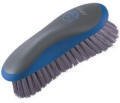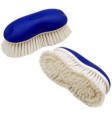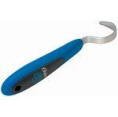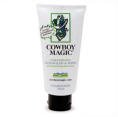
- Grooming Your Horse - |
|||||||||||||||
Brushing To brush your horse, you should have at least three brushes, a curry comb, and a mane comb. There should be a stiff brush for getting mud off of your horse's coat, a medium brush for cleanup, and a soft brush for the face and legs. Use the currycomb first to loosen any manure or mud buildup on the horse's coat, using circular motions over his neck, back, belly, and hindquarters. Press firmly, but not so hard you hurt the horse. This will take a little practice, and not every horse likes the same amount of pressure. If your horse has sensitive skin, they may need a lighter touch. You don't want your strokes to be so light that they tickle your horse though. Make sure when you're done with the grooming tools you knock what dirt you can from them so you won't have to do it the next time you get them out. There is less chance of infection this way, too, so there is less chance of your horse becoming ill. Always take care of your tools and the benefits are numerous. Then use the stiffest brush you have, stroking in motions following the way the horse's hair grows, to sweep off the majority of the loosened dirt from the currycomb's work. Once this is done, use the next brush in line, the medium stiff brush, to clean up whatever the stiff brush missed. by this time your horse should look pretty good, but there's still his face and legs to contend with. Your soft brush should have bristles of horsehair or something equally soft, because your horse's face is the most delicate part of him. Make sure you brush around his ears to get off any dried sweat from the bridle area the last time you rode him, and be careful around his eyes. Don't poke the bristles into his eyes. Be sure to get under the halter so you don't miss anything. Also be careful around his nose, because just inside his nostrils as very sensitive skin. You can use a damp sponge to clean off any buildup around this area.
Hoof Picking After you brush your horse properly, it's time to pick out his hooves. Chances are, if he's been out in the field or standing in his stall he's gotten a buildup of wood shavings or dirt and even rocks in his hooves. It's up to you to clean it out for him so you can ride. Start by picking out his right front hoof. Stand on his right side facing his hindquarters. Run your hand down the inside of his leg and as you near the bottom, lean into his shoulder a little and squeeze his leg. This is a signal the you want his to pick up his hoof. Usually he'll do it. After he gives you his foot, prop it up on your knee to he doesn't have to hold it up and you'll have some support and stability. Using the hoof pick in whichever hand you prefer, put the point facing away from you and stroke downward. There is a "v" at the middle of the back of his foot that you shouldn't mess with. This is the frog. Sometimes the horse's frog can be mistaken for dirt and hay. Be careful of this when you pick your horse's hoofs. There is an inverted V that you should pick out, though. make sure you get under his shoes if he's wearing horseshoes. If there are any rocks stuck under his hoof, he might come up lame after you've been riding him for a bit. You need to be sure that you clean out his hooves completely before and after every time you ride. Mane and Tail Care Your horse's mane and tail should be brushed each time you groom. If your horse is pasture kept, you know from experience how tangled and full of burrs and sticks they can get! Meticulous care by taking these things out each time you groom will not only improve your horse's appearance, but also his health. If he continually rips his tail out on branches, he won't have much left to swat at the flies in the summertime! You can get special brushes for your horse's tail, and also Cowboy Magic, my most recommended tail detangler. The stuff is amazing - you get a lot for your money, and it lasts a really long time. You can also use a tail bag to keep your horse's tail clean and neat.
Rub Cowboy Magic or another detangler through your horse's tail and then brush it out slowly, beginning at the bottom. Then carefully separate each strand until your horse's tail is hanging long and straight and fluffy. At that point you can braid it, band it at the bottom, and slip the tail bag up over it to keep everything from getting ruined. Your horse's mane should not be so long that it looks unkempt. Keep it short if you show western, or long enough to braid if you show English. Otherwise there really is no reason other than appearance to keep your horse's mane long. Long manes are far more difficult to take care of, and take a lot more time to detangle. Consider carefully before choosing a mane length - a horse's mane takes about a year to grow six to eight inches. Bathing When washing your horse, you can use a sweat scraper to scrape off the excess water. Don't leave it to just drip off; usually this annoys the horses and makes them kick.
Back to the Horse Care page |
|||||||||||||||
|
|||||||||||||||









